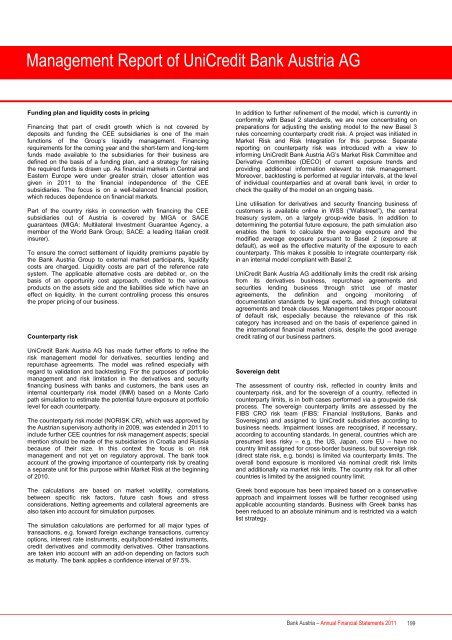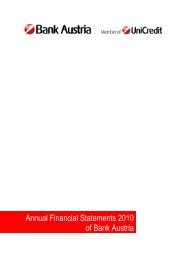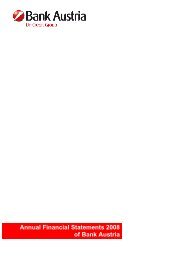Annual Financial Statements 2011 of Bank Austria
Annual Financial Statements 2011 of Bank Austria
Annual Financial Statements 2011 of Bank Austria
You also want an ePaper? Increase the reach of your titles
YUMPU automatically turns print PDFs into web optimized ePapers that Google loves.
Management Report <strong>of</strong> UniCredit <strong>Bank</strong> <strong>Austria</strong> AG<br />
Funding plan and liquidity costs in pricing<br />
Financing that part <strong>of</strong> credit growth which is not covered by<br />
deposits and funding the CEE subsidiaries is one <strong>of</strong> the main<br />
functions <strong>of</strong> the Group’s liquidity management. Financing<br />
requirements for the coming year and the short-term and long-term<br />
funds made available to the subsidiaries for their business are<br />
defined on the basis <strong>of</strong> a funding plan, and a strategy for raising<br />
the required funds is drawn up. As financial markets in Central and<br />
Eastern Europe were under greater strain, closer attention was<br />
given in <strong>2011</strong> to the financial independence <strong>of</strong> the CEE<br />
subsidiaries. The focus is on a well-balanced financial position,<br />
which reduces dependence on financial markets.<br />
Part <strong>of</strong> the country risks in connection with financing the CEE<br />
subsidiaries out <strong>of</strong> <strong>Austria</strong> is covered by MIGA or SACE<br />
guarantees (MIGA: Multilateral Investment Guarantee Agency, a<br />
member <strong>of</strong> the World <strong>Bank</strong> Group; SACE: a leading Italian credit<br />
insurer).<br />
To ensure the correct settlement <strong>of</strong> liquidity premiums payable by<br />
the <strong>Bank</strong> <strong>Austria</strong> Group to external market participants, liquidity<br />
costs are charged. Liquidity costs are part <strong>of</strong> the reference rate<br />
system. The applicable alternative costs are debited or, on the<br />
basis <strong>of</strong> an opportunity cost approach, credited to the various<br />
products on the assets side and the liabilities side which have an<br />
effect on liquidity. In the current controlling process this ensures<br />
the proper pricing <strong>of</strong> our business.<br />
Counterparty risk<br />
UniCredit <strong>Bank</strong> <strong>Austria</strong> AG has made further efforts to refine the<br />
risk management model for derivatives, securities lending and<br />
repurchase agreements. The model was refined especially with<br />
regard to validation and backtesting. For the purposes <strong>of</strong> portfolio<br />
management and risk limitation in the derivatives and security<br />
financing business with banks and customers, the bank uses an<br />
internal counterparty risk model (IMM) based on a Monte Carlo<br />
path simulation to estimate the potential future exposure at portfolio<br />
level for each counterparty.<br />
The counterparty risk model (NORISK CR), which was approved by<br />
the <strong>Austria</strong>n supervisory authority in 2009, was extended in <strong>2011</strong> to<br />
include further CEE countries for risk management aspects; special<br />
mention should be made <strong>of</strong> the subsidiaries in Croatia and Russia<br />
because <strong>of</strong> their size. In this context the focus is on risk<br />
management and not yet on regulatory approval. The bank took<br />
account <strong>of</strong> the growing importance <strong>of</strong> counterparty risk by creating<br />
a separate unit for this purpose within Market Risk at the beginning<br />
<strong>of</strong> 2010.<br />
The calculations are based on market volatility, correlations<br />
between specific risk factors, future cash flows and stress<br />
considerations. Netting agreements and collateral agreements are<br />
also taken into account for simulation purposes.<br />
The simulation calculations are performed for all major types <strong>of</strong><br />
transactions, e.g. forward foreign exchange transactions, currency<br />
options, interest rate instruments, equity/bond-related instruments,<br />
credit derivatives and commodity derivatives. Other transactions<br />
are taken into account with an add-on depending on factors such<br />
as maturity. The bank applies a confidence interval <strong>of</strong> 97.5%.<br />
In addition to further refinement <strong>of</strong> the model, which is currently in<br />
conformity with Basel 2 standards, we are now concentrating on<br />
preparations for adjusting the existing model to the new Basel 3<br />
rules concerning counterparty credit risk. A project was initiated in<br />
Market Risk and Risk Integration for this purpose. Separate<br />
reporting on counterparty risk was introduced with a view to<br />
informing UniCredit <strong>Bank</strong> <strong>Austria</strong> AG’s Market Risk Committee and<br />
Derivative Committee (DECO) <strong>of</strong> current exposure trends and<br />
providing additional information relevant to risk management.<br />
Moreover, backtesting is performed at regular intervals, at the level<br />
<strong>of</strong> individual counterparties and at overall bank level, in order to<br />
check the quality <strong>of</strong> the model on an ongoing basis.<br />
Line utilisation for derivatives and security financing business <strong>of</strong><br />
customers is available online in WSS (“Wallstreet”), the central<br />
treasury system, on a largely group-wide basis. In addition to<br />
determining the potential future exposure, the path simulation also<br />
enables the bank to calculate the average exposure and the<br />
modified average exposure pursuant to Basel 2 (exposure at<br />
default), as well as the effective maturity <strong>of</strong> the exposure to each<br />
counterparty. This makes it possible to integrate counterparty risk<br />
in an internal model compliant with Basel 2.<br />
UniCredit <strong>Bank</strong> <strong>Austria</strong> AG additionally limits the credit risk arising<br />
from its derivatives business, repurchase agreements and<br />
securities lending business through strict use <strong>of</strong> master<br />
agreements, the definition and ongoing monitoring <strong>of</strong><br />
documentation standards by legal experts, and through collateral<br />
agreements and break clauses. Management takes proper account<br />
<strong>of</strong> default risk, especially because the relevance <strong>of</strong> this risk<br />
category has increased and on the basis <strong>of</strong> experience gained in<br />
the international financial market crisis, despite the good average<br />
credit rating <strong>of</strong> our business partners.<br />
Sovereign debt<br />
The assessment <strong>of</strong> country risk, reflected in country limits and<br />
counterparty risk, and for the sovereign <strong>of</strong> a country, reflected in<br />
counterparty limits, is in both cases performed via a groupwide risk<br />
process. The sovereign counterparty limits are assessed by the<br />
FIBS CRO risk team (FIBS: <strong>Financial</strong> Institutions, <strong>Bank</strong>s and<br />
Sovereigns) and assigned to UniCredit subsidiaries according to<br />
business needs. Impairment losses are recognised, if necessary,<br />
according to accounting standards. In general, countries which are<br />
presumed less risky – e.g. the US, Japan, core EU – have no<br />
country limit assigned for cross-border business, but sovereign risk<br />
(direct state risk, e.g. bonds) is limited via counterparty limits. The<br />
overall bond exposure is monitored via nominal credit risk limits<br />
and additionally via market risk limits. The country risk for all other<br />
countries is limited by the assigned country limit.<br />
Greek bond exposure has been impaired based on a conservative<br />
approach and impairment losses will be further recognised using<br />
applicable accounting standards. Business with Greek banks has<br />
been reduced to an absolute minimum and is restricted via a watch<br />
list strategy.<br />
<strong>Bank</strong> <strong>Austria</strong> – <strong>Annual</strong> <strong>Financial</strong> <strong>Statements</strong> <strong>2011</strong> 199
















